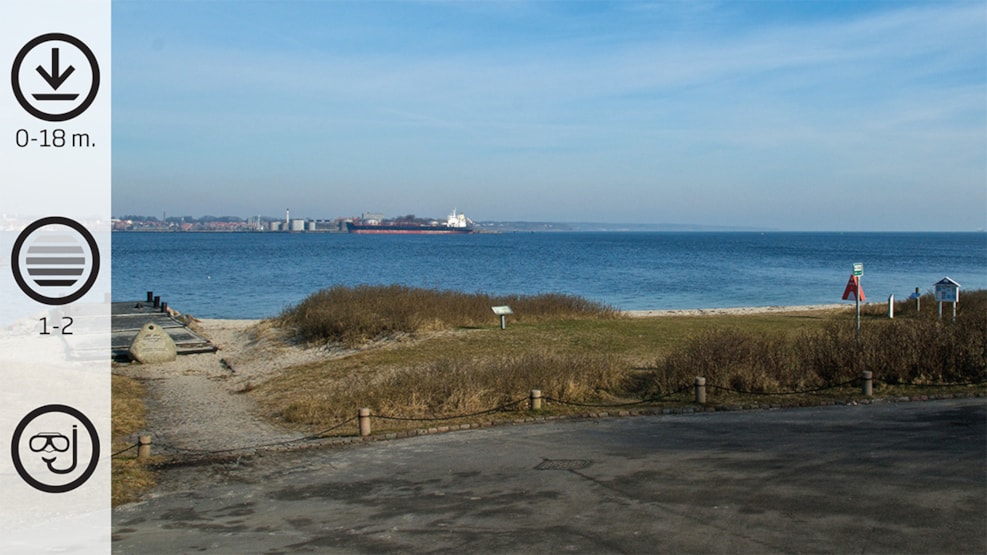
Diving spot Strib Nordstrand
Old tree trunks with many hiding places for animals such as hermit crabs. Many of the smaller species such as butterfish, threespine sticklebacks, gobies, but eels also benefits from the hiding places at the tree trunks.
Facts:
How to find: Coming from E20, choose Exit 58, and follow the signs towards Strib, At the T-crossing at 1,5 Km., turn left towards Strib at Strib Landevej. Follow the road all through the town, until you can go no further, then turn right first exit after Nørre Allé. Here you can see Lillebælt right in front of you.
Geocoordinates:
Longitude: 9.7608293928
Latitude: 55.544000148
Google Earth Coordinates:
Latitude: 55°32'38.51"N
Longtitude: 9°45'38.76"Ø
Getting in and up the water: At both sides of the platform with the 2 cannons.
Highlights: Tree trunks with plenty of sea life. Suitable for snorkeling.
Air filling station: You can get your airbottle refilled at Hindsgavl Camping in Middelfart (open all year round) during opening times: Hindsgavl Camping. Alternatively ask the local diving club in Middelfart, Tel.: +45 3311 1323 : Dykkerklubben Marsvinet
Best season: All year round. The summer and spring are best for watching the marine life.
Dangerous areas: Avoid going too far out in the belt, the tide can be strong
Depth: 0-18 metres.
Tide: The tide can be strong
Level of difficulty (1-5): 1-2
Permissions: None
Facilities: Toilets, parking space and picnic sets. Bakery, Kiosk, Pizzaria and restaurant within 500 metres from the beach.
Photo opportunities: Wide angle and macro.
Strib Nordstrand
This dive site is located at the northern part of Snævringen - on Funen. Here you will find toilets, parking and picnic sets, just 20 metres from the water's edge. To the left of the parking space, 100 metres ahead, Strib lighthouse can be seen and around the corner to the right, Røjle Klint.
At the lighthouse a reef extends outwards, the seabed on the reef is a variation of gravel, stone and sandy seabed. Diving here requires a boat, as you can very easily be blown off the reef by the often strong tide.
If you enter the water by the platform with the canons, with a view of Fredericia on the other side of the belt, put on your fins and glide effortlessly beneath the surface. Here you can dive without much danger that the tide takes you into the middle of the belt.
The platform, which formerly was the berthing place for the ferry that sailed between Strib and Fredericia, marks with cannon and cannon balls, the memory of the German bombardement of Strib on the 8th of May 1848, which led to the burning of Færgegården.
The water right of the platform is the most popular area to dive in, as the seabed and the sea life here is very varied. The seabed slopes slightly downwards, and after having passed through an common ellgrass belt, the seabed changes into a mixture of gravel and sand. You are now on 5 -6 metres depth and often see the first small cod here.
The diving site also offers shoals of herring in the season (late spring) and then there are plenty of opportunities to see and hear porpoises, but not with scuba equipment, as the sound usually scares them away.
Strib Nordstrand is also a great place if you want to experience flatfish. The seabed conditions are ideal for plaice and turbot and especially in the summer months there are many to see.
At the seabed there are some tree trunks and is thus ideal hiding places for the hermit crabs, which thrive here. The tree trunks are helping to make the dive here into something special. Many of the smaller species such as butterfish, threespine sticklebacks and gobies, but eels also enjoy hiding places at the tree trunks. The trunks, which are brought here from Røjle Klint by the power of the tide, also indicate that it is a popular spot for anglers. You can quickly assemble gear worth of a small fortune, all attached to the strains. Diving a little further out - 6 to 8 metres depth, you will experience larger rocks, which is nicely overgrown with yellow and orange breadcrumb sponge.
Here are many interesting photo subjects - both macro and wide angle. Further out in the belt at 10-12 metres depth, you can find even larger rocks with sugarkelp and plumose anemones and on the seabed around the rocks, the chance to find sea anemones and often large flatfish is high.